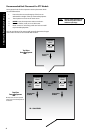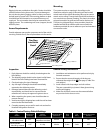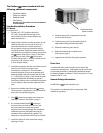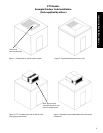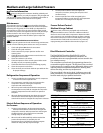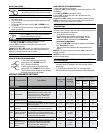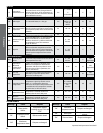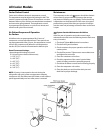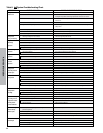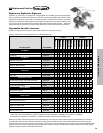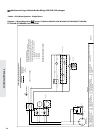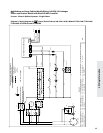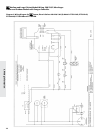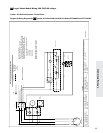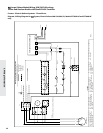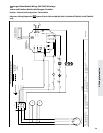
12
4. Service Information
Table 5. System Troubleshooting Chart
PROBLEM POSSIBLE CAUSES POSSIBLE CORRECTIVE STEPS
Compressor 1. Main switch open. 1. Close switch.
will not run 2. Fuse blown. 2. Check electrical circuits and motor winding for shorts or grounds.
Investigate for possible overloading. Replace fuse after fault is corrected.
3. Thermal overloads tripped. 3. Overloads are automatically reset. Check unit closely when unit comes
back on line.
4. Defective contactor or coil. 4. Repair or replace.
5. System shut down by safety devices. 5. Determine type and cause of shutdown and correct it before resetting
safety switch.
6. No cooling required. 6. None. Wait until calls for cooling.
7. Motor electrical trouble. 7. Check motor for open windings, short circuit or burn out.
8. Loose wiring. 8. Check all wire junctions. Tighten all terminal screws.
Compressor 1. Flooding of refrigerant into crankcase. 1. Check setting of expansion valves.
noisy or vibrating 2. Worn compressor. 2. Replace.
High 1. Non-condensables in system. 1. Remove the non-condensables.
discharge 2. Fan not running. 2. Check electrical circuit. Replace if motor fails.
pressure 3. Dirty condenser coil. 3. Clean.
4. System overcharged with refrigerant. 4. Reclaim refrigerant and recharge proper amount.
Low discharge 1. Insucient refrigerant in system. 1. Check for leaks. Repair and add charge.
pressure 2. Low suction pressure. 2. See corrective steps for low suction pressure.
High suction 1. Excessive load. 1. Reduce load or add additional equipment.
pressure 2. Expansion valve overfeeding. 2. Check remote bulb. Regulate superheat.
Low 1. Lack of refrigerant. 1. Check for leaks. Repair and add charge (see refrigerant charge chart).
suction 2. Evaporator dirty or iced. 2. Clean.
pressure 3. Expansion valve malfunctioning. 3. Check and reset for proper superheat.
4. Condensing temperature too low. 4. Check ambient temp, 50°F to 100°F.
Compressor 1. Operating beyond design conditions. 1. Add equipment so that conditions are within allowable limits.
thermal protector 2. Dirty condenser coil. 2. Clean coil.
switch open 3. Overcharged system. 3. Reduce charge (see refrigerant charge).
Fan(s) will 1. Main switch open. 1. Close switch.
not operate 2. Blown fuses. 2. Replace fuses. Check for short circuits or overload conditions.
3. Defective motor. 3. Replace motor.
4. Defective defrost control. 4. Replace defective component.
5. Unit in defrost cycle. 5. Wait for completion of cycle.
6. Coil does not get cold enough to reset thermostat 6. Adjust fan delay setting of control. See Defrost Section page 8.
Room 1. Control cut out set too high. 1. Adjust control.
temperature 2. Superheat too high. 2. Adjust thermal expansion valve.
too high 3. System low on refrigerant. 3. Add refrigerant. See refrigerant charge chart.
4. Coil iced-up. 4. Manually defrost coil. Check defrost controls for malfunction.
Ice accumulating 1. Defrost duration is too long. 1. Adjust defrost termination temp on control. See page 8.
on ceiling around 2. Fan delay not delaying fans after defrost period. 2. Adjust fan delay setting or replace bad sensor.
evaporator and/or 3. Defective defrost control or sensor. 3. Replace defective control or sensor. See page 10 error codes.
on fan guards' 4. Too many defrosts. 4. Adjust number of defrosts.
venturi or blades
Coil not clearing 1. Coil temperature not getting above freezing 1. Check heater operation.
of frost during point during defrost.
defrost cycle. 2. Not enough defrost cycles per day. 2. Adjust control for more defrost cycles.
3. Defrost cycle too short. 3. Adjust defrost control, defrost duration setting.
4. Defective defrost control or sensor. 4. Replace defective component. See page 10 error codes.
Ice accumulating 1. Defective heater. 1. Replace heater.
in drain pan 2. Unit not installed properly (out of level) 2. Check and adjust if necessary. See pages 7, 8.
3. Drain line plugged. 3. Clean drain line.
4. Defective control. 4. Replace defective component.



